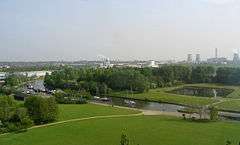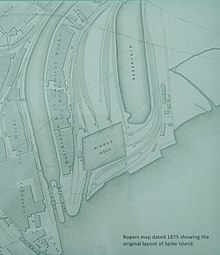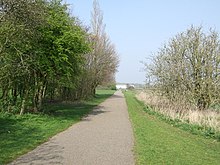Spike Island, Widnes
Spike Island is a park in Widnes, Halton, North-West England. It is an artificial island between the Sankey Canal and the estuary of the River Mersey containing parkland, woodland, wetlands and footpaths. It is next to the Catalyst Science Discovery Centre, an interactive science and technology museum.
| Spike Island | |
|---|---|
 Spike Island viewed from Catalyst Science Discovery Centre | |

| |
| Type | Park and Urban open space |
| Location | Widnes, Cheshire, England |
| Coordinates | 53°21′14″N 2°43′50″W |
| Operated by | Halton Borough Council |
In 1833, Widnes Dock, the world's first rail-to-ship dock, was built on the island. In 1848, John Hutchinson built the first chemical factory in Widnes on the island. The chemical industry in Widnes grew rapidly thereafter. By the 1970s no working chemical factories remained, and from 1975 onwards the island was cleaned up and turned over to public recreation.
A famous concert by the Stone Roses, subsequently the subject of an eponymous film, took place on the island in May 1990.
History


Spike Island is an artificial island created in 1833 when the Sankey Canal was extended from Fiddler's Ferry to the River Mersey at Widnes. The extension separated a section of Widnes previously called Woodend from the remainder of the town.[1] The canal passes from the West Bank Locks on Spike Island to Warrington and then into St. Helens town centre. The canal fell into disuse and closed in 1963. The canal footpath now forms part of the Trans Pennine Trail.
The island was at the centre of the British chemical industry during the 19th century and part of the Industrial Revolution. Widnes Dock, built in 1833, was the first rail-to-ship dock in the world.[2] Uniquely the dock allowed goods, such as coal, to be taken off a train and deposited directly into a boat for transport along the River Mersey to other parts of the UK and abroad. Goods and raw materials could also be brought in via a boat and then deposited directly onto a train for onward travel to local factories. The dock was topped up with water from the nearby reservoir to prevent its level becoming too low when the River Mersey was at low tide. Large ships are unable to sail far up the River Mersey because the water level is too low. Consequently Widnes dock was accessed by Mersey flat boats which could transport goods downstream to the Port of Liverpool or along the canal network. The Mersey flats were small flat-bottomed sailing barges that originated on the Mersey but were later used on rivers elsewhere. They were a common sight in the 19th century. The wreck of a Mersey flat called the Eustace Carey can be seen at Spike Island at low tide.[3]
Beginning in 1848, John Hutchinson built the first chemical factory in Widnes on Spike Island. It was called "Hutchinson's No 1 Works" and was constructed along the Sankey Canal near Widnes Dock. Thereafter chemical factories proliferated in the town. Around the year 1860 Hutchinson built Tower Building, which he used as the administrative headquarters of his chemical business. Later it became the head office of the Gossage soap company, which at one time was the largest soap company in the UK and handled half of the UK's soap exports.[4][5] Today, Tower Building houses the Catalyst Science Discovery Centre. Hutchinson was described by his contemporaries as "the father of Widnes" because of his influence on the growth of the chemical industry in the town.
The chemical industry for the first time allowed the mass production of soap, bleaching powder, glass, fertilizer and textiles, amongst other products. With the mass production came a reduction in the cost of those products allowing for their use by more people. The population of the town grew rapidly; however, the industry also brought exceptional levels of pollution. Widnes was described as one of the dirtiest and most dangerous places to work in England, and in 1905 as a "poisonous hell-town".[6]
In the 20th century, changes to the industry and new environmental laws led to the decline of the chemical industry. By the 1970s Spike Island contained abandoned chemical factories, rail lines, canal and industrial dockage, and extensive chemical pollution. Between 1975 and 1982 the island was reclaimed and returned to green spaces. All of the chemical works were removed and only two former pyrite kilns remain.
Facilities


The island is maintained by Halton Borough Council, who describe the island as "Open parkland with items of industrial archaeological interest and a canal".[7] There are footpaths, canal walks, cycle paths, woodland, wetlands, birdlife, fishing, industrial heritage, picnic tables, car parking, a multi-purpose sports pitch, a children's play area and the Trans Pennine Trail passes through the parkland.[7]
Mersey riverboats are moored in the Sankey Canal. The canal, although in water, is not navigable past the island because footbridges form an obstruction. Halton Borough Council has the long-term aim of restoring the canal to use by watercraft and has committed to building a new swing bridge on the island and re-opening the slipway between the canal and Mersey. The council has also committed to finding an alternative water supply for the canal which has lost water formerly supplied by the now-closed Fiddlers Ferry Power Station.[8]
The Catalyst Science Discovery Centre is a museum dedicated to science and in particular chemistry. It is next to the island and charts the history of Widnes and Spike Island, offering hands-on displays, static displays and live science lectures. There are 80 interactive exhibits and re-constructed scenes bringing science, maths, engineering and technology to life. Two teaching spaces host a range of workshops and there is a café. There is an observatory on the top floor accessed via a glass-walled lift. The observatory offers panoramic views of the river, Widnes and the Mersey Gateway Bridge, which was opened in 2017.[9]
In popular culture
Spike Island was the site of a famous outdoor concert by The Stone Roses in May 1990.[10] The support acts included DJs Dave Haslam, Paul Oakenfold and Frankie Bones, a Zimbabwean drum orchestra, Dave Booth (DJ) and the reggae artist Gary Clail.[11] The NME wrote "Spike Island was to be the Roses' defining statement, a celebration of not only their own success, but of an entire youth culture" and also "It was a real moment in time; the beginning of a long hot summer that saw England nearly go all the way in the World Cup, the peak of a period when Manchester and the north-west felt like the centre of the universe."[11] 30,000 people attended the concert; the organisation was described as "amateurish", and this increased the fame of the event. The police informed the organisers that the tide was so high that everyone might have to be taken off the island. As the Stone Roses took to the stage a cloud of red dust formed in front of the stage, triggering asthma attacks among some members of the crowd.[11]
A film about the concert called Spike Island was released in 2012.[12] The Pulp song "Sorted for E's and Wizz" is inspired by one girl's memories of the concert. Jarvis Cocker remarked that he'd spoken to the girl about the concert and she could remember virtually nothing apart from the drug taking.[13] A tribute concert on the island by "The Clone Roses" was planned for May 2020, thirty years after the original concert.[14] The event was rescheduled for 2021 because public gatherings were prohibited because of the COVID-19 pandemic.[15]
References
- "History Of Spike Island – 1757 To 1990 – Widnes, UK". waymarking.com. Retrieved 12 August 2020.
- Welbourn, Nigel (2008). Lost Lines: Liverpool and the Mersey. Hersham: Ian Allan. p. 4. ISBN 978-0-7110-3190-6.
- "The Harry Arnold Archive – The Closure Years". Sankey Canal Restoration Society. Retrieved 12 August 2020.
- Crosland, Lesley (May 1989). "CATALYST A Museum For Change". STEAM Magazine.
- Hardie, David William Ferguson (1950). A History of the Chemical Industry of Widnes. London: Imperial Chemical Industries Limited, General Chemicals Division. p. 56. ASIN B0007JBZRQ.
- Ankers, Steve (2018). Northern Soles. SilverWood Books. ISBN 1781327955.
- "Spike Island". Visit Halton. Halton Borough Council. n.d. Retrieved 6 August 2020.
- "Halton Council's New Bridge a Commitment to Restore Sankey Canal". Halton Borough Council. n.d. Retrieved 12 August 2020.
- "Home page". Catalyst Science Discovery Centre and Museum. Retrieved 12 August 2020.
- "BBC Short film on the Stone Roses Spike Island concert". BBC.
- Nicolson, Barry (27 May 2020). "The Stone Roses: The Full Story Of Spike Island, 30 Years On". NME. Retrieved 12 August 2020.
- Wright, Jade (26 March 2012). "New film to relive The Stone Roses' classic gig at Spike Island in Widnes". Liverpool Echo. Retrieved 31 March 2012.
- Gallagher, Paul (13 January 2015). "'Sick Drugs Stunt': That Time when Pulp Were 'sorted for E's & Wizz'". Dangerous Minds. Retrieved 12 August 2020.
- Rice, Elle May (3 December 2019). "Spike Island 30th anniversary show to take place in 2020". Liverpool Echo. Retrieved 12 August 2020.
- "Spike Island 30th anniversary celebrations postponed due to coronavirus". Radio X. 1 April 2020. Retrieved 12 August 2020.
| Wikimedia Commons has media related to Spike Island, Cheshire. |